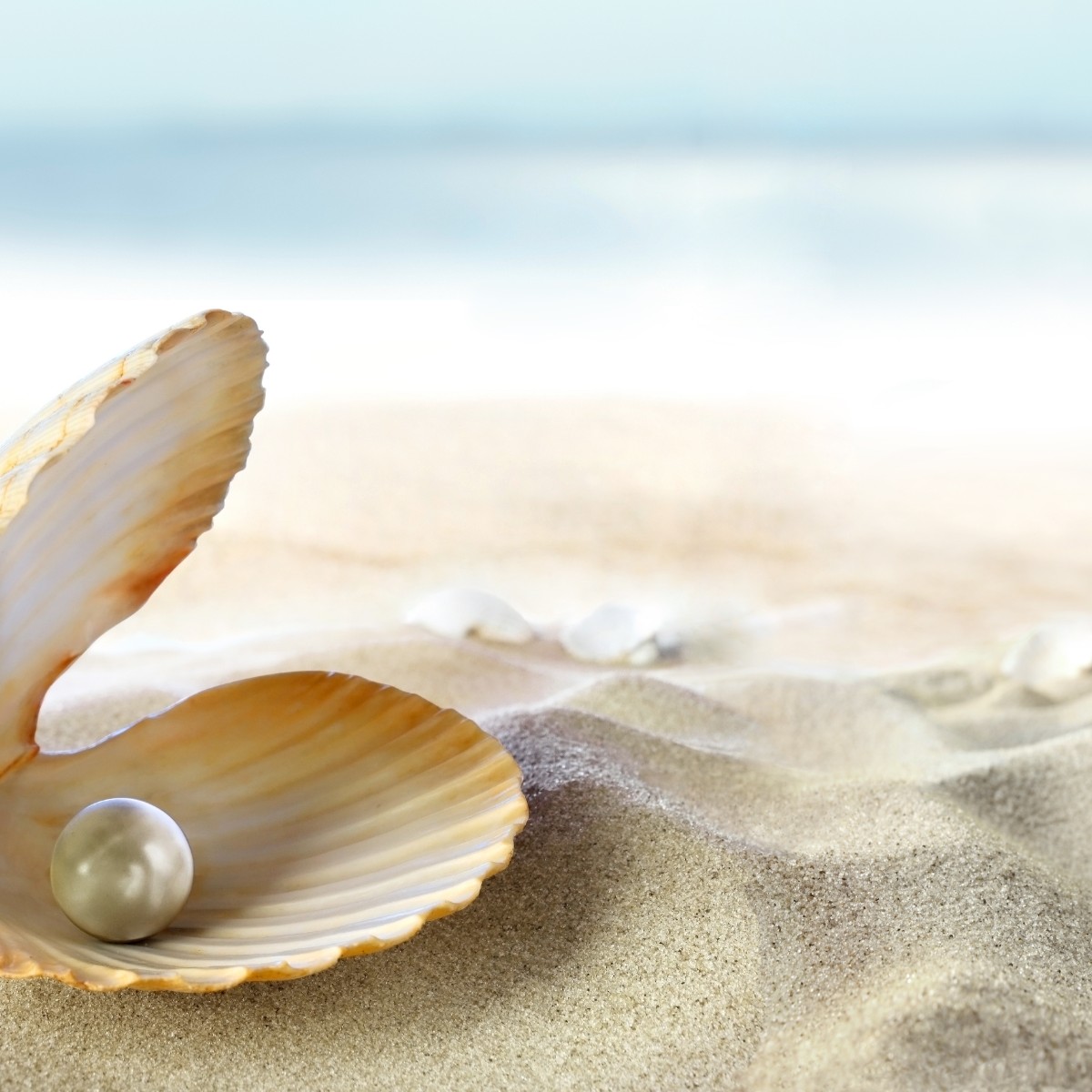
Perls are believed to have been revered and traded as long as 6,000 years ago. The first Pearls to be held by human hands were likely discovered on the shores of India as fish-eating locals searched for food. Pearls were being given as ornamental gifts in Ancient China as far back as 2,250 BC and have been used in jewelry as personal adornment since at least 450 BC.
With demand outstripping supply by such a large degree, Japanese entrepreneur Mikimoto Kokichi set out to discover a way to cultivate Pearls and bring an element of stability to their availability. In 1893 he made a revolutionary breakthrough when he and his wife Ume successfully cultured a Pearl under human supervision, and over the following years he perfected his technique, a combination of art and science. We are now able to culture Pearls in special oyster nurseries where these mystifying creatures are protected and tended to by expert guardians. Each mollusc is painstakingly cared for over a number of years, allowing nature to do what she always does best - create a stunning gemstone.
A Pearl is one of just a handful of organic gems (the other well-known ones being Coral, Amber and Jet). Rather than being a mineral, Pearls actually grow inside a mollusc, a term used for all shells that open and close on a hinge, such as oysters, clams, and mussels. Organic gemstones don’t usually have a traditional crystal structure or composition, but Pearl is made up of calcium carbonate (mostly Aragonite), which features an orthorhombic crystal structure. This builds the Pearl up in concentric layers, leading to the unique visual quality that Pearls display.
Pearl formation is fascinating, and is totally different to how other gemstones form. If a foreign object, such as a grain of sand, enters a mollusc it becomes an irritant to the creature inside, so in order to protect itself it releases a silky substance, known as nacre (essentially Mother-of-Pearl, which also lines the shell), to cover the uninvited guest. Over time the mollusc will continue to release nacre over the foreign body and when the mollusc is opened years after the initial intrusion, the uninvited guest has been turned into a glorious Pearl. Pearls essentially exist as the result of a defence mechanism. It is amazing to think how nature can turn an unwelcome grain of sand into one of the most gorgeous gems in the world.
The term 'Cultured Pearl' alone tends to mean that the Pearl has been cultivated in the ocean (saltwater) whereas 'Freshwater Cultured Pearl' refers to those that are cultivated inland in lakes. Over 99% of Pearls sold today worldwide are Cultured Pearls of one type or the other.
When buying new Pearls, it is not really a case of natural Pearls versus Cultured Pearls, but Cultured Pearls versus entirely synthetic, man-made Pearls. If you own Pearls and are not sure if they are genuine or not, a great way to test them is to rub them on your teeth. If the Pearl feels slightly grainy rather than smooth, it’s a real Pearl, be that natural or cultured. If it’s smooth, however, you know it is not a real Pearl, as companies who produce imitation, synthetic Pearls have yet to master the grainy effect of natural nacre. Quite often these imitations are just plastic or glass made to look like a Pearl.
Round, flawless, and orient are words you’ll hear relating to Pearls and these are qualities used to determine their value.
The word round seems a bit of an obvious one to describe a Pearl but it is in fact the most important. It’s a common mistake to think Pearls have been faceted in some way to give them their perfect spherical shape, when in fact the shape of a Pearl is all down to the work done by the mollusc. Because no two Pearls are identical in shape or size, it takes a skilled jeweler hours and hours to select matching Pearls when stringing them together for necklaces and bracelets.
The finest Pearls do not have any flaws, bumps or marks in the nacre and they should have an even and clean surface.
The final consideration when valuing Pearls is their orient. This is the word used to describe the luster of a Pearl (also referred to as pearlescence). The orient is a soft iridescence caused by the refraction of light off the layers of nacre.
Every Pearl is individually graded on five virtues, the first of which is its luster. The luster of a Pearl is the most important factor but also the hardest to determine. However, with a trained eye it becomes an instinctive process. A Pearl’s complexion is under significant scrutiny as any imperfections may alter their value.
Due to the Pearl's shape it has often been associated with the moon.
GEMOLOGICAL PROPERTIES OF PEARL
- Color White, pink, yellow, orange, silver, cream, purple, golden, brown, green, blue, black
- Family Organics
- Mohs Scale Hardness 2.5 - 4.5
- Specific Gravity 2.60 - 2.85
- Refractive Index 1.52 - 1.69
- Luster Pearly
- Crystal System Orthorhombic
- Transparency Translucent
- Chemical Formula CaCO3
- Composition Calcium Carbonate
Where do Pearls come from? Well, those known as Freshwater Cultured Pearls are created using freshwater river mussels and farmed from sources mostly in Japan and China. Cultured Pearls (without 'Freshwater' in the description) are created using saltwater Pearl oysters and are largely farmed from the oceans around the Philippines, Australia and French Polynesia. The variance in locale and the mollusc used to create this organic gem give us the different hues of Pearl.
PEARL VARIETIES
The Pinctada Maxima silver-lipped oyster is found in Australia and produces incredible white-silver Pearls. It is considered the largest and rarest of the Pearl oysters, and is valued highly not just because of the Pearls created, but also because of the sheer quality of its Mother-of-Pearl, which is sought after in its own right. The farm from where these Pearls are sourced is harboured in the perfect spot (chosen from a long history of trial and error), allowing the oyster to absorb the rich nutrients and minerals from the immaculate waters that surround it. These oysters are tended by hand, painstakingly cleaned and protected in the deep from their formidable predators and environment. The oyster’s gift is a perfect silver-white Pearl, each one a unique treasure from the deep. There is also a golden-lipped Pinctada Maxima oyster which provides a sublime golden variety of South Sea Pearl. Pearls from these waters can very rarely display other subtle variations in hue.In the atolls and lagoons of French Polynesia exists a unique paradise that brings the world the Tahitian Pearl. This Pearl is a relative newcomer to the market, having been popularized in the later 19th century. It is a natural, dark, exotic Pearl sometimes known as a Black Pearl, though they actually come in every color other than jet black. Its myriad of different colors make strands of striking Pearls that are almost impossible to produce and extremely difficult to match. Behind every great Pearl is its oyster. The Mother-of-Pearl that brings us this Tahitian variety is the illustrious and legendary Pinctada Margaritifera or black-lipped Pearl oyster. Rarely has one of the most expensive Pearls on the planet run the risk of being upstaged by its host, but this is a testament to this beautiful and mysterious oyster.
Maruata Pearls are sourced in the crystal clear waters of French Polynesia, like their Tahitian counterparts mentioned above. The Maruata Pearl nursery has a world-class reputation for producing some of the very finest Black Pearls on the market, and the farmers care for and nurture the Pinctada Margaritifera oysters on a daily basis. The oysters are regularly cleaned and moved into new areas of perfect temperature and suitability should the ideal cultivation conditions fluctuate. The reason we differentiate between Tahitian and Maruata Pearls at Gemporia, even though they share a provenance, is because Maruata Pearls are afforded extra time to grow - normally 21 months to two years where other Pearls may be given 12 to 18 months. To signify their longer gestation period and resultant larger size, we only set Maruata Pearls into gold when making our Pearl jewelry.
Some of the world’s most beautiful Freshwater Cultured Pearls come from the Kaori Pearl nursery, one of the biggest Pearl farms in China, where they take a considerable amount of time to cultivate their finished Pearls. Their reputation within the industry is stellar. The freshwater lakes of China offer ideal growing conditions for these fine quality Pearls and offer up a range of shapes, sizes and color hues that allow for an incredible variety of designs for our finished pieces. From classic Pearl necklaces and effortlessly wearable Pearl bracelets to dainty rings and highly stylish pendants, the Pearl is timeless; it never goes out of fashion, its elegance transcends generations, and we’re very proud of all of the different Pearl collections we can offer here at Gemporia.
HOW TO CLEAN PEARL
Despite originating underwater, it is recommended not to submerge Pearls in water when caring for them. Use a very soft lint-free microfiber cloth to gently clean your Pearls, and if you need a little help, dampen part of the cloth with some mildly soapy lukewarm water. Dry them immediately with a dry part of the cloth. Don't use any heat to dry excess moisture, though you can gently blow on them to evaporate any extra liquid. Pay particular attention to the string if cleaning necklaces and bracelets - keep it as dry as you can. Don't take your Pearls anywhere near a steam or ultrasonic cleaner.HOW TO CARE FOR PEARL
Pearl comes in at between 2.5 and 4.5 on the Mohs scale, making it arguably the most popular gemstone to be so low on the famed hardness table - even a fingernail can be hard enough to scratch a Pearl at the bottom end of this range. However, taking good care of your Pearls isn't at all laborious. The most important thing to do when wearing Pearls is to put them on last when you're getting ready as they're vulnerable to all sorts of cosmetic products such as perfume and hairspray. Likewise, take them off first when you're done. Keep them safely stored away from other jewelry and away from extreme temperature and light sources. Give them a wipe down with a soft cloth after wearing, and if you have Pearls that are strung in a necklace or bracelet remember to periodically check the state of the threading material. They may occasionally need re-stringing. When cared for properly, Pearls will last a lifetime. Wear them often as the body’s natural oils help maintain the Pearl’s orient (pearlescence).References:
https://www.gemporia.com

